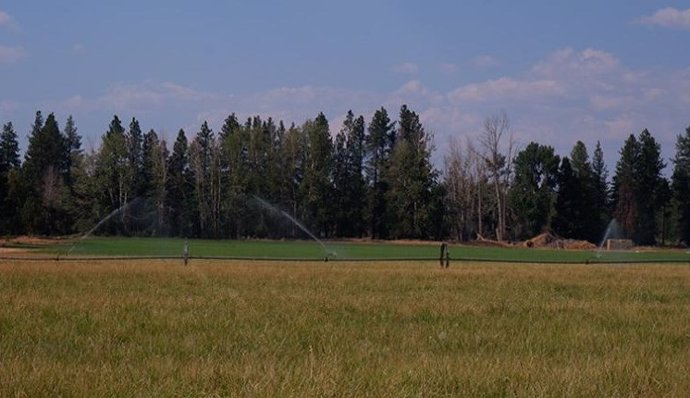Global wood supply is threatened by northward shift of cropland due to climate change – UNIVERSITY OF CAMBRIDGE
Aug. 29 () –
Climate change will displace and reduce the area of land suitable for growing food and wood, which will put the production of these two vital resources in direct competition.
The sight of vineyards in Britain is becoming more common as warmer summers create ever more suitable conditions for growing grapes. But behind this success story there is something to think about: Climate change is shifting regions of the world suitable for growing crops.
Researchers at the University of Cambridge have discovered a looming problem: as the land suitable for producing our food moves north, the land we need to grow trees will shrink. The wood these trees produce is the basis of much of modern life, from paper and cardboard to furniture and buildings.
They say the growing competition between land for timber production and food production due to climate change has so far been overlooked, but is set to become an emerging issue as our demand for both continues to rise.
In the worst-case scenario for climate change, if no steps are taken to decarbonize society, the study found that more than a quarter of existing forest land (about 320 million hectares, equivalent to the size of India) will be more suitable for agriculture by the end of the century.
Most forests for timber production are currently located in the Northern Hemisphere, in the United States, Canada, China and Russia. The study concluded that 90% of all current forest land that will be productive for agriculture in 2100 will be in these four countries.
In particular, tens of millions of hectares of timber-producing land in Russia will be converted to agriculture (more than in the United States, Canada and China combined), and conditions will become favorable for the cultivation of potatoes, soybeans and wheat.
“There is only a finite area of suitable land on the planet where we can produce food and wood, two critical resources for society. “As climate change worsens and agriculture is forced to expand northwards, there will be increasing pressure on wood production,” he said. in a statement Dr Oscar Morton, a researcher at the Department of Plant Sciences at the University of Cambridge, who co-led the study.
“We have to think fifty years ahead because if we want wood in the future, we have to plant it now.“The trees that will be cut down at the end of this century are already in the ground; they have much slower cycles than food crops,” said Dr Chris Bousfield, a postdoctoral researcher in the Department of Plant Sciences at the University of Cambridge and co-leader of the study.
Global food demand is projected to double by 2050 as the population grows and becomes wealthier. Global demand for wood is also expected to double in the same time period, largely because it is a low-carbon alternative to concrete and steel for construction.
Moving timber production to deeper areas of boreal or tropical forests is not a viable option, because the trees in those regions have remained intact for thousands of years and Cutting them down would release huge amounts of carbon and threaten biodiversity.
“One of the main environmental risks of increasing competition for land between agriculture and forestry is that timber production will shift to the remaining areas of primary forest within the tropics or boreal zones. These are the epicentres of the world’s remaining wilderness and intact tropical forests are the most biodiverse places on Earth. It is essential to prevent further expansion“said David Edwards, Professor of Plant Ecology in the Department of Plant Sciences at the University of Cambridge and lead author of the study.
To arrive at their results, the researchers took satellite data showing intensive forestry around the world and overlaid it with predictions of agricultural land suitable for the world’s key crops, including rice, wheat, corn, soybeans and potatoes, in the future under various climate change scenarios.
Even in the best-case scenario, when the world reaches net-zero emissions goals, researchers say there will still be significant future changes in regions suitable for timber and crop production.
The study is published in the journal Nature Climate Change.
Timber production contributes more than US$1.5 trillion annually to national economies worldwide. Heatwaves and associated wildfires have caused massive recent losses of timber forests around the world. Climate change is also driving the spread from pests such as the bark beetle, which attacks trees.
Climate change is expected to make areas of the tropics too hot and inhospitable for growing food and make large areas of southern Europe much less suitable for food and wood production.
“Climate change is already causing challenges for wood production. Now, on top of that, there will be increased pressure from agriculture, creating a perfect storm of problems”Bousfield said.
“Securing our future wood supply may not seem as urgent as securing the food we need to eat and survive. But wood is equally integrated into our daily lives and we need to develop strategies to ensure food and wood security in the future,” Morton said.




![[Img #74674]](https://thelatestnews.world/wp-content/uploads/2024/12/Santiago-Ramon-y-Cajal-The-promoter-of-modern-neuroscience-150x150.jpg)








![[Img #74674]](https://thelatestnews.world/wp-content/uploads/2024/12/Santiago-Ramon-y-Cajal-The-promoter-of-modern-neuroscience-300x200.jpg)


Add Comment